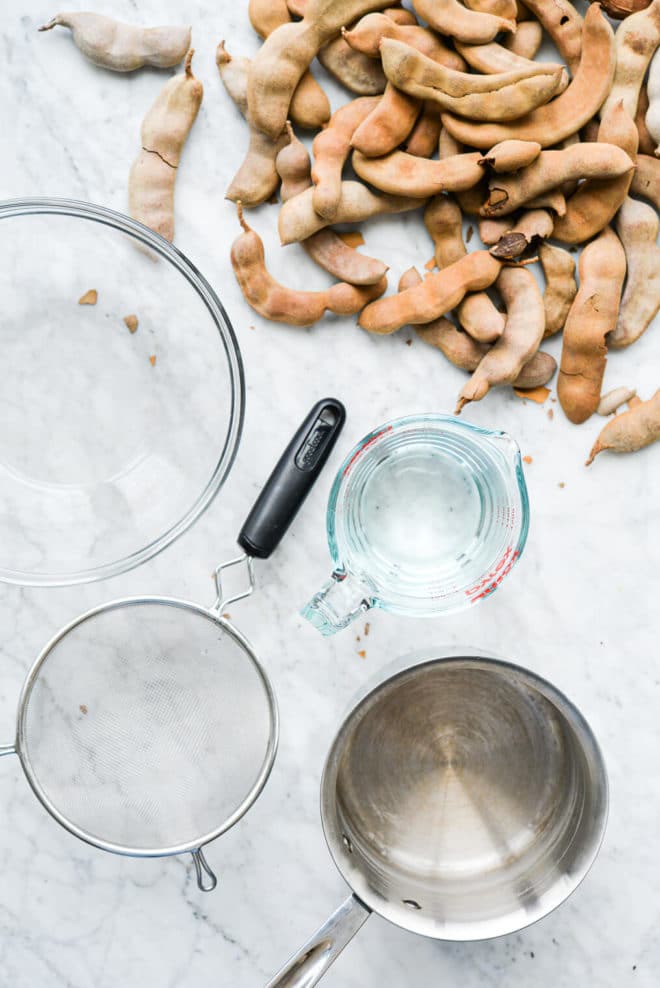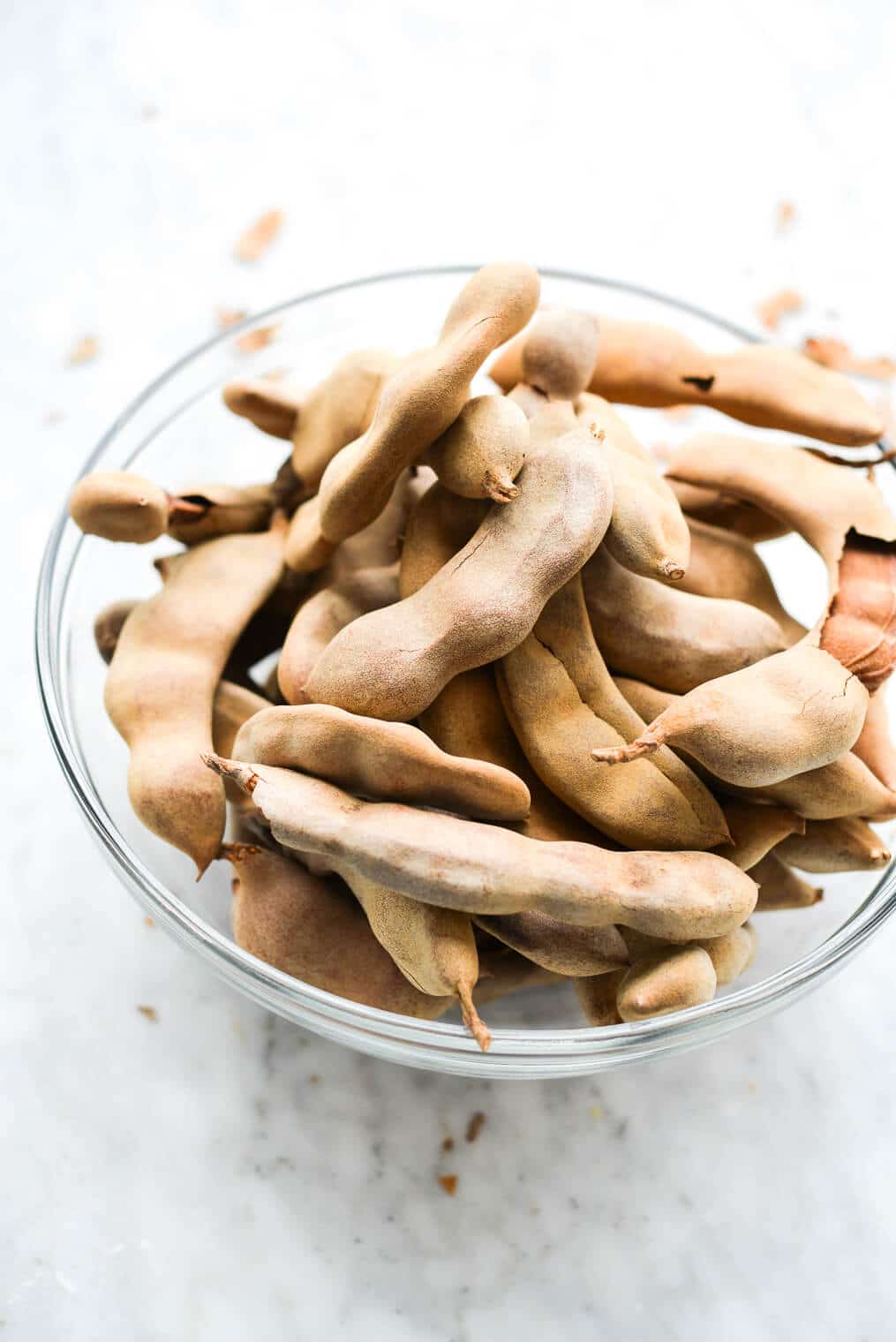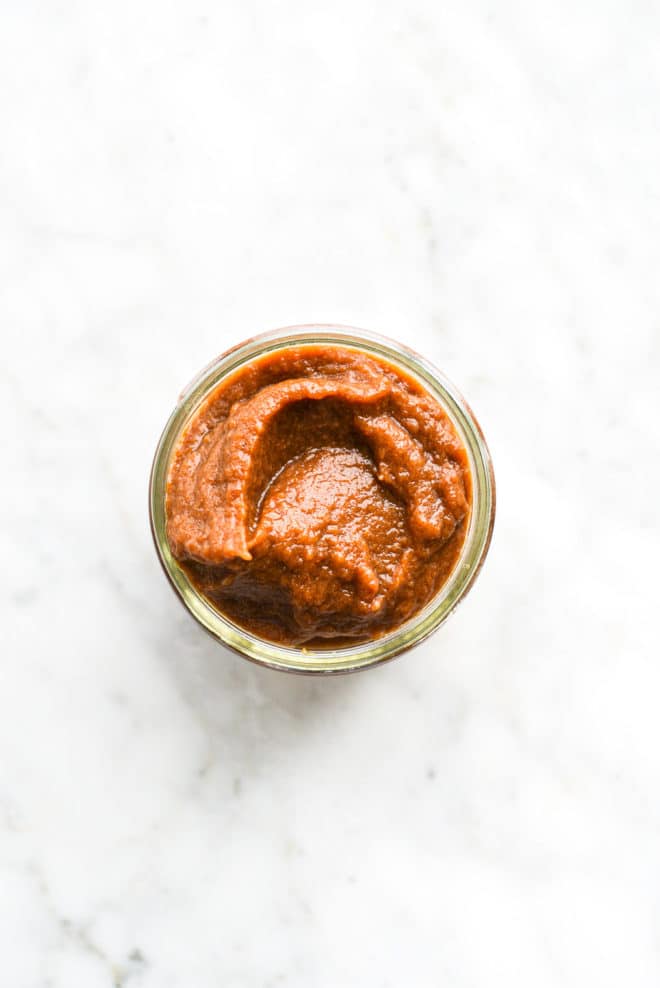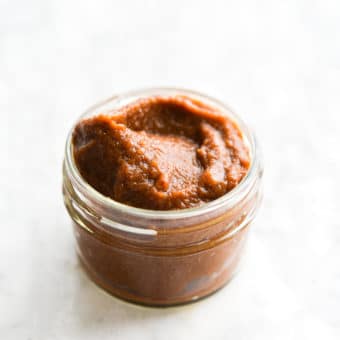Tamarind paste is such a fun ingredient to have on hand — its unique sour, sweet flavor has the ability to add so much depth to so many different dishes!

Tamarind Paste Recipe
The sour, sweet flavor of tamarind paste is incredibly unique and adds such a depth of flavor to so many dishes from all sorts of cuisines! If you’re looking to change up the flavors in your meals, tamarind paste is an excellent addition to your kitchen, and making it is much simpler than it seems. We also really love that tamarind paste has a long shelf life, meaning that you’ll be able to use (or freeze!) leftover tamarind paste rather than waste it.
Though this recipe only yields about 4 ounces of tamarind paste, it’s important to remember that it’s like garlic in that a little goes a long way, so 4 ounces of tamarind paste will actually last you quite a bit longer than you may suspect!
What is Tamarind Paste?
Before understanding what tamarind paste is, you first need to know what tamarind is! Tamarind is a dark brown, sticky fruit that grows in pods from a tamarind tree. It has a sour taste (if eaten raw, it almost tastes like a Sour Patch Kid!).
Tamarind paste is simply tamarind fruit that has been shelled, boiled, softened, filtered, and mashed. Tamarind paste is used around the world in both savory and sweet dishes!

Ingredients for Making Tamarind Paste at Home
The ingredients list is very short, y’all! The only ingredients you need to make tamarind paste are…
- Tamarind – you’ll need about 1 pound of shell-on tamarind pods. Try your best to only buy pods that are uncracked, as cracked pods tend to have a dried out fruit inside.
- Boiling water – in order to soften the shelled tamarind pods, you’ll need boiling water. For every 4 ounces of shelled tamarind that you have, you’ll need a ½ cup of boiling water.
Equipment Needed




How to Make Tamarind Paste from Pods
If you’re going this route (which is exactly what we did), know that you do have a bit of work ahead of you, but it’ll be totally worth it! If you’re making tamarind paste from raw, shell-on tamarind pods, you’ll need to…
- Do a quick scan of the tamarind pods – give each of your tamarind pods a quick look. If you see any that are already partly peeled, super cracked, or have mold on them, go ahead and throw those out.
- Shell the tamarind – you’ll need to first shell the tamarind pods by hand. If there are pieces of the shell that are really stuck to the flesh that you’re having trouble getting off, just leave them – any small pieces of shell will come off in the hot water. We just want to get the bulk of the shell off of the pods.
- Soak – once your tamarind pods are shelled, put them in a large glass bowl, pour the boiling water over top, and let the pods soak in the water for 30 minutes. Use a spoon to press the pods down so that they are all submerged in the water, OR, stir and “turn over” the pods a couple of times throughout the 30 minute time period.
- Grate the tamarind flesh – once the water is cool to the touch, place the mesh strainer over a bowl (different from the one that the pods are soaking in), and with your hands, take the softened tamarind flesh and rub it on the strainer, essentially grating off the flesh into the bowl under the strainer and leaving behind the seeds, membranes, and any remaining shells in the strainer itself.
- Scrape any remaining tamarind flesh from the strainer – after all of the softened pods have been grated into the bowl, flip the strainer over, and using a spoon or spatula, scrape off any remaining flesh that may have clung to the strainer, and discard the water that the tamarind was soaking in.
- Store – store in the fridge in a mason jar or airtight container of your choice! See below for more storage tips.




How to Make Tamarind Paste from Block
If you’re not interested in all of the peeling + grating associated with making tamarind paste totally from scratch, feel free to make your paste from a block of tamarind flesh (or pulp) if you can find one at your grocery store. To make a paste from a block of tamarind pulp, you’ll simply:
- Remove the compressed tamarind pulp from the package, break it into a few chunks, and place it in a large heat-safe bowl.
- Pour boiling water over top of the tamarind. Remember, the general rule here is a ½ cup of boiling water per 4 ounces of tamarind pulp.
- Mash the pulp and water together with a spoon.
- Let soak for 20-30 minutes.
- Press the chunks of tamarind pulp through a fine mesh strainer, with a clean bowl underneath to catch the smooth tamarind paste.
Storage Tips
Because of the citric acid (Vitamin C) in tamarind, this paste actually has a long shelf life. We recommend storing your tamarind paste in a mason jar in the refrigerator for 3-4 weeks. For a longer-lasting option, freeze the tamarind paste by spooning it into small silicone or plastic ice cube trays, freezing, and storing the cubes in a labeled freezer bag for up to 5 months.

Does Tamarind Paste Go Bad?
It does. If your tamarind paste has been in the fridge for a while and you’re worried about the safety or quality of it, simply check to see if it has mold (obviously a very sure sign that it needs to be tossed) or has an off smell. If it has neither of these, it’s probably just fine! To be on the safe side, though, we don’t typically use refrigerated (homemade) tamarind paste that is older than 4-ish weeks.
What Can I Do With Tamarind Paste?
There are a ton of options, actually! Tamarind paste is often used in Thai, Mexican, Indian, and Vietnamese cuisine (among many others around the globe), so if you’re looking to make a really delicious, authentic recipe from one of these cuisines, tamarind paste is likely to be on the ingredients list. Here are a few recipes that include tamarind paste that are definitely worth trying out:
- Tamarindo Candy – Muy Delish
- Atole de Tamarindo – Mexico in My Kitchen
- Pad Thai – The Woks of Life
- Creamy Tamarind Chicken Curry – My Heart Beets
If you’re looking for a fun spin on a margarita + you have some tamarind paste to spare, try out our tamarind margarita – it’s absolutely delicious!

What Tastes Similar to Tamarind?
Tamarind has a tart, sour taste with just a hint of sweetness. If you’re looking to replace the tamarind in a recipe with something you have on hand, you can try either a combination of vinegar and sugar or plain, fresh lime juice.
Is Tamari the same as Tamarind?
It isn’t. Tamari is a bottled gluten-free soy sauce, while tamarind is a fruit that grows from a tree! Very different, but both really delicious in their own right!
Tamarind Paste Recipe

Ingredients
- 1 pound tamarind pods with shells
Instructions
- First, you’ll need to first shell the tamarind pods by hand. Discard any pods that are moldy or heavily cracked. If there are pieces of the shell that are really stuck to the flesh that you’re having trouble getting off, just leave them – any small pieces of shell will come off in the hot water. We just want to get the bulk of the shell off of the pods.
- Once your tamarind pods are shelled, put them in a large glass bowl, then pour 1/2 cup boiling water over top, and let the pods soak in the water for 30 minutes. Use a spoon to press the pods down so that they are all submerged in the water, OR, stir and “turn over” the pods a couple of times throughout the 30 minute time period.
- Once the water is cool to the touch, place the mesh strainer over a bowl (different from the one that the pods are soaking in), and, with your hands, take the softened tamarind flesh and rub it on the strainer, essentially grating off the flesh into the bowl under the strainer and leaving behind the seeds, membranes, and any remaining shells in the strainer itself.
- After all of the softened pods have been grated into the bowl, flip the strainer over, and using a spoon or spatula, scrape off any remaining flesh that may have clung to the strainer, and discard the water that the tamarind was soaking in.
- Store in the fridge in a mason jar or airtight container of your choice! The paste will keep for up to 4 weeks in the refrigerator or for up to 5 months in the freezer.













